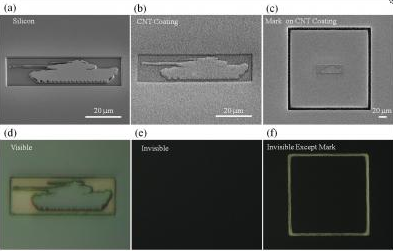Carbon nanotube forest camouflages 3-D objects
November 22, 2011

Scanning electron microscope images show a tank etched out of silicon, with and without a carbon nanotube coating (top row). When the same structures are viewed under white light with an optical microscope (bottom row), the nanotube coating camouflages the tank structure against a black background. (Credit: L. J. Guo et al., University of Michigan)
University of Michigan researchers are taking advantage of the unique low refractive index of carbon nanotubes’ low-density aligned nanotubes to demonstrate a new application: making 3-D objects appear as nothing more than a flat, black sheet.
The refractive index of a material is a measure of how much that material slows down light, and carbon nanotube “forests” have a low index of refraction very close to that of air. Since the two materials affect the passage of light in similar ways, there is little reflection and scattering of light as it passes from air into a layer of nanotubes.
The researchers realized they could use this property to visually hide the structure of objects. They manufactured a 3-D image of a tank out of silicon. When the image was illuminated with white light, reflections revealed the tank’s contours, but after the researchers grew a forest of carbon nanotubes on top of the tank, the light was soaked up by the tank’s coating, revealing nothing more than a black sheet.
By absorbing instead of scattering light, carbon nanotube coatings could cloak an object against a black background, such as that of deep space, the researchers note. In such cases, the carbon nanotube forest “acts as a perfect magic black cloth that can completely conceal the 3-D structure of the object,” the researchers write.
Ref.: Haofei Shi et al., Low density carbon nanotube forest as an index-matched and near perfect absorption coating, Applied Physics Letters (in press)